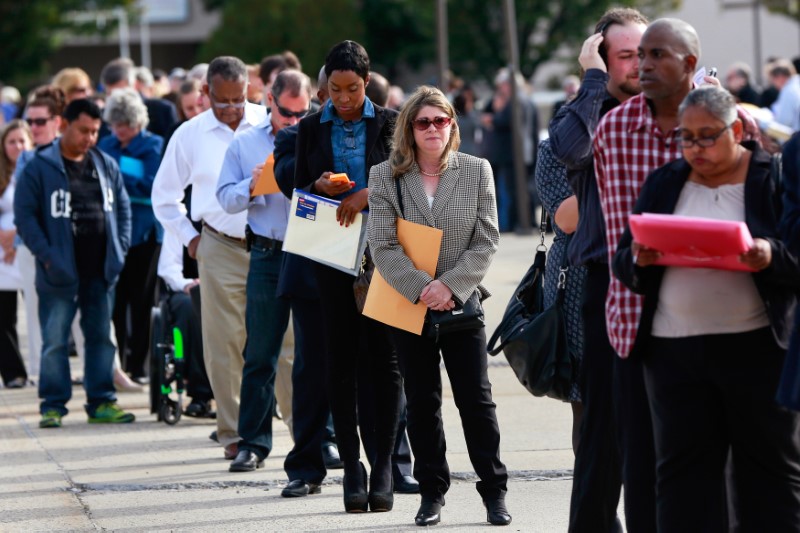By Lucia Mutikani
WASHINGTON (Reuters) - U.S. employment increased less than expected in December but a rebound in wages pointed to sustained labor market momentum that sets up the economy for stronger growth and further interest rate increases from the Federal Reserve this year.
Nonfarm payrolls rose by 156,000 jobs last month, the Labor Department said on Friday. The gains, however, are more than sufficient to absorb new entrants into the labor market.
Fed Chair Janet Yellen has said the economy needs to create just under 100,000 jobs a month to keep up with growth in the work-age population. Employers hired 19,000 more workers than previously reported in October and November.
"Job creation and overall labor market conditions remain solid. With the potential for stronger fiscal stimulus in the form of infrastructure spending and tax cuts, job creation appears likely to remain on a solid footing in 2017," said Jim Baird, chief investment officer for Plante Moran Financial Advisors in Kalamazoo, Michigan.
The economy created 2.16 million jobs in 2016. Average hourly earnings increased 10 cents or 0.4 percent in December after slipping 0.1 percent in November. That pushed the year-on-year increase in earnings to 2.9 percent, the largest gain since June 2009, from 2.5 percent in November.
While the unemployment rate ticked up to 4.7 percent from a nine-year low of 4.6 percent in November, that was because more people entered the labor force, a sign of confidence in the labor market. Economists had forecast payrolls rising by 178,000 jobs last month.
The dollar rose against a basket of currencies, while prices for U.S. government bonds fell. Stocks on Wall Street were trading higher.
Other data on Friday showed the trade deficit widening 6.8 percent to $45.2 billion in November as imports rose to their highest level in more than a year on higher oil prices.
The employment report added to data ranging from housing to manufacturing and auto sales in suggesting that President-elect Donald Trump is inheriting a strong economy from the Obama administration. The labor market momentum is likely to be sustained amid rising business and consumer confidence.
Trump, who takes over from President Barack Obama on Jan. 20, has pledged to increase spending on the country's aging infrastructure, cut taxes and relax regulations. These measures are expected to boost growth this year.
But the proposed expansionary fiscal policy stance could increase the budget deficit. That, together with faster economic growth and a labor market that is expected to hit full employment this year could raise concerns about the Fed falling behind the curve on interest rate increases.
Last month's wage growth left it just shy of the 3.0 percent to 3.5 percent range that economists say is needed to lift inflation to the Fed's 2.0 percent target.
"This is coming well before any fiscal stimulus hits. It plays to the idea that the Fed may already be behind the curve, not least because the impetus from lower oil prices has turned more inflationary as well," said Alan Ruskin, FX Research head at Deutsche Bank (DE:DBKGn) in New York.
The U.S. central bank raised its benchmark overnight interest rate last month by 25 basis points to a range of 0.50 percent to 0.75 percent. The Fed forecast three rate hikes this year.
FACTORY JOBS INCREASE
A broad measure of unemployment that includes people who want to work but have given up searching and those working part-time because they cannot find full-time employment fell one-tenth to a more than 8-1/2-year low of 9.2 percent.
Employment growth in 2016 averaged 180,000 jobs per month, down from an average gain of 229,000 per month in 2015. The slowdown in job growth is consistent with a labor market that is near full employment.
There has been an increase in employers saying they cannot fill vacant positions because they cannot find qualified workers. The skills shortage has been prominent in the construction industry.
"The pool is all but drained especially for skilled workers. We can't bring factory jobs back because there's no one out there to run them," said Chris Rupkey, chief economist at
MUFG Union Bank in New York.
The labor force participation rate, or the share of working-age Americans who are employed or at least looking for a job, rose one-tenth of percentage point to 62.7 percent in December.
The participation rate remains near multi-decade lows. Some of the decline reflects demographic changes.
December's job gains were broad, with manufacturing payrolls rising 17,000 after declining for four straight months. Construction payrolls fell 3,000 in December after three consecutive months of increases.
Retail sector employment rose 6,300 after increasing 19,500 in November. Department store giants Macy's (N:M) and Kohl's Corp (N:KSS) this week reported a drop in holiday sales. Macy's said it planned to cut 10,000 jobs beginning this year.
Department stores have suffered from stiff competition from online rivals including Amazon.com (O:AMZN). Temporary help declined 15,500 last month, the biggest drop since January.

Education and health services employment rose 70,000, the biggest increase since February. Government employment increased 12,000 in December.